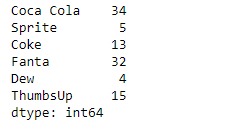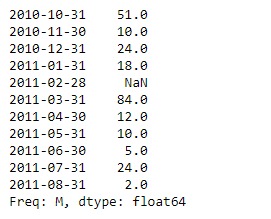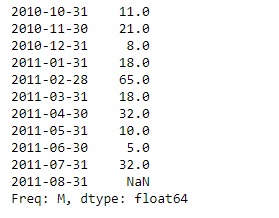| Python Pandas Series.corr()用法及代码示例 | 您所在的位置:网站首页 › 函数series › Python Pandas Series.corr()用法及代码示例 |
Python Pandas Series.corr()用法及代码示例
|
Pandas 系列是带有轴标签的一维ndarray。标签不必是唯一的,但必须是可哈希的类型。该对象同时支持基于整数和基于标签的索引,并提供了许多方法来执行涉及索引的操作。 Pandas Series.corr()函数计算与其他系列的相关性,排除缺失值。 用法: Series.corr(other, method=’pearson’, min_periods=None)参数: other:系列 method:{'pearson','kendall','spearman'}或可致电 min_periods:获得有效结果所需的最少观察数 返回:相关性:浮点数 范例1:采用Series.corr()函数查找给定系列对象与另一个对象的相关性。 # importing pandas as pd import pandas as pd # Creating the first Series sr1 = pd.Series([80, 25, 3, 25, 24, 6]) # Creating the second Series sr2 = pd.Series([34, 5, 13, 32, 4, 15]) # Create the Index index_ = ['Coca Cola', 'Sprite', 'Coke', 'Fanta', 'Dew', 'ThumbsUp'] # set the first index sr1.index = index_ # set the second index sr2.index = index_ # Print the first series print(sr1) # Print the second series print(sr2)输出:
现在我们将使用Series.corr()函数查找给定系列对象的基础数据与其他对象之间的相关性。 # find the correlation result = sr1.corr(sr2) # Print the result print(result)输出:
范例2:采用Series.corr()函数查找给定系列对象与另一个对象的相关性。系列对象包含一些缺失值。 # importing pandas as pd import pandas as pd # Creating the first Series sr1 = pd.Series([51, 10, 24, 18, None, 84, 12, 10, 5, 24, 2]) # Creating the second Series sr2 = pd.Series([11, 21, 8, 18, 65, 18, 32, 10, 5, 32, None]) # Create the Index index_ = pd.date_range('2010-10-09', periods = 11, freq ='M') # set the first index sr1.index = index_ # set the second index sr2.index = index_ # Print the first series print(sr1) # Print the second series print(sr2)输出:
现在我们将使用Series.corr()函数查找给定系列对象的基础数据与其他对象之间的相关性。 # find the correlation result = sr1.corr(sr2) # Print the result print(result)输出:
|
【本文地址】
公司简介
联系我们


 正如我们在输出中看到的,Series.corr()函数已成功返回给定系列对象的基础数据之间的相关性。
正如我们在输出中看到的,Series.corr()函数已成功返回给定系列对象的基础数据之间的相关性。

 正如我们在输出中看到的,Series.corr()函数已成功返回给定系列对象的基础数据之间的相关性。在计算对象之间的相关性时,将跳过缺少的值。
正如我们在输出中看到的,Series.corr()函数已成功返回给定系列对象的基础数据之间的相关性。在计算对象之间的相关性时,将跳过缺少的值。